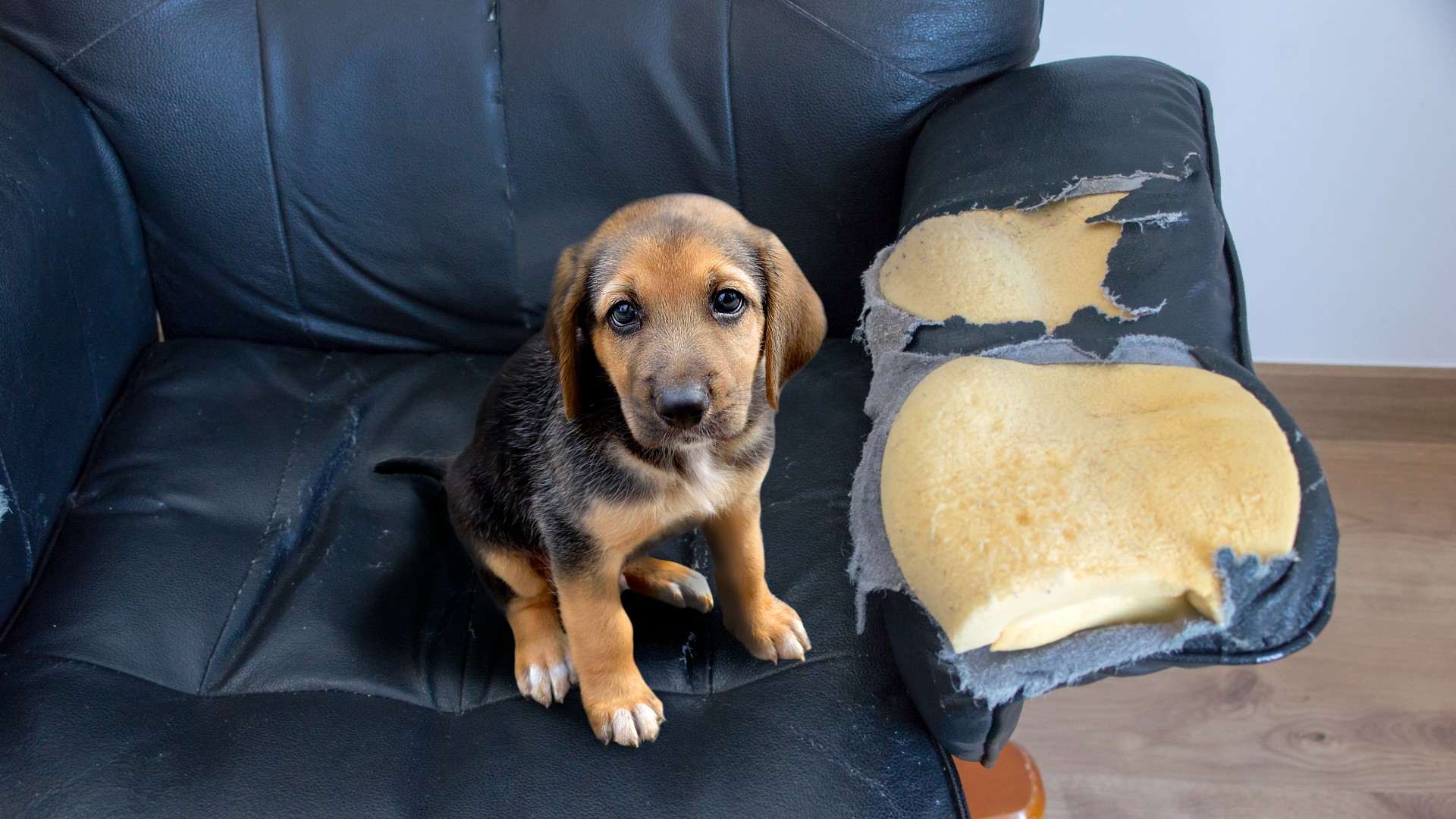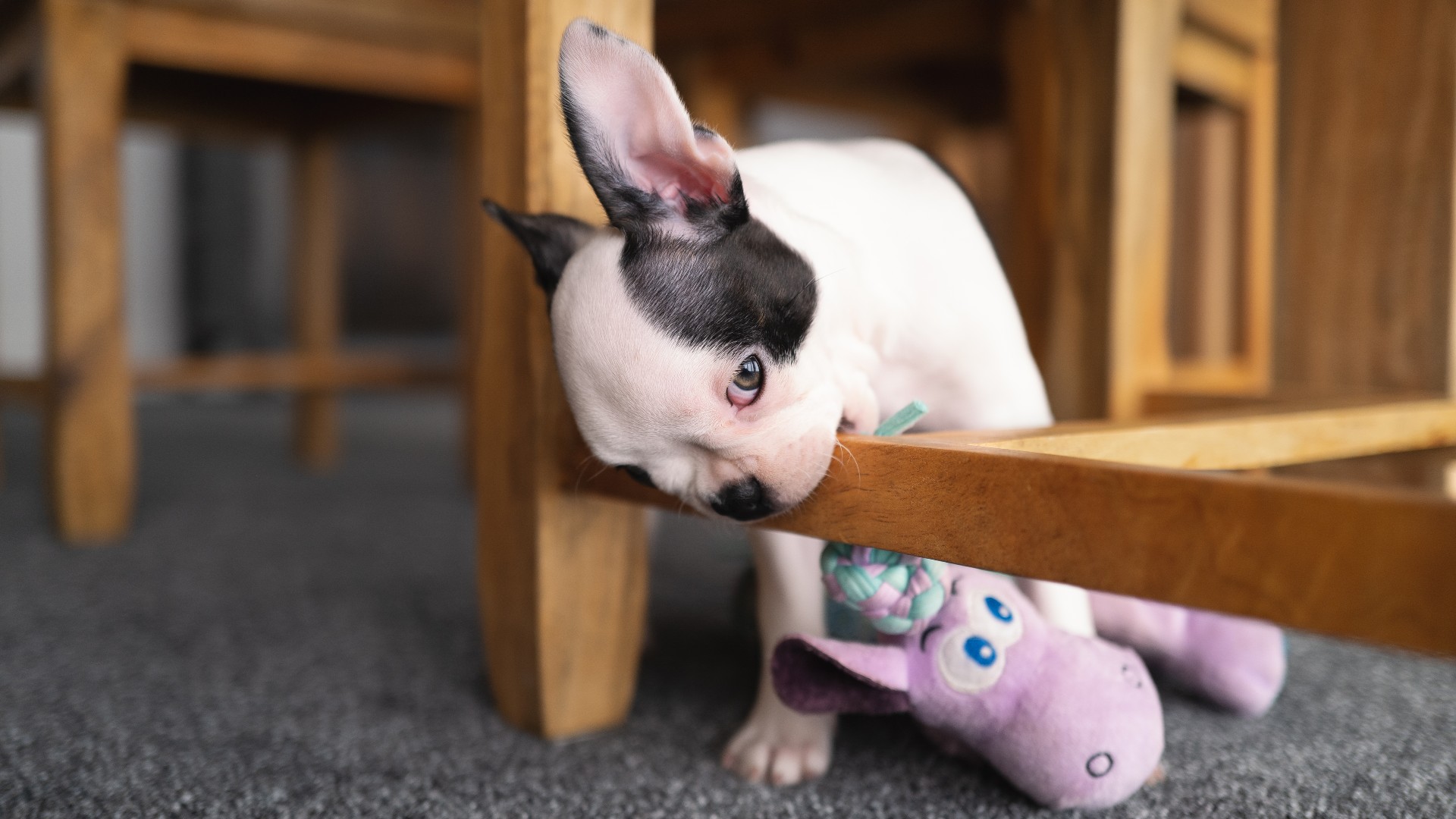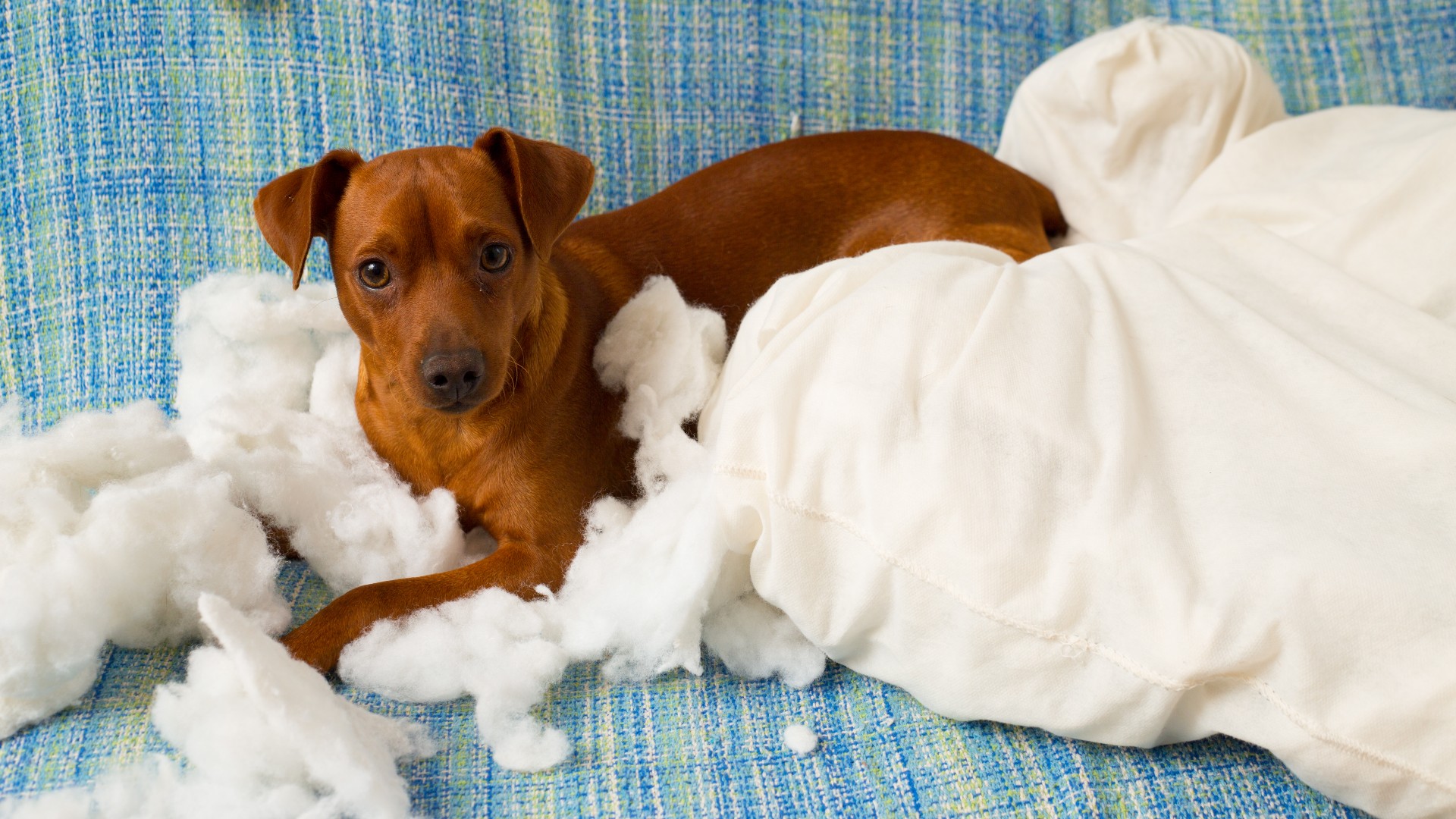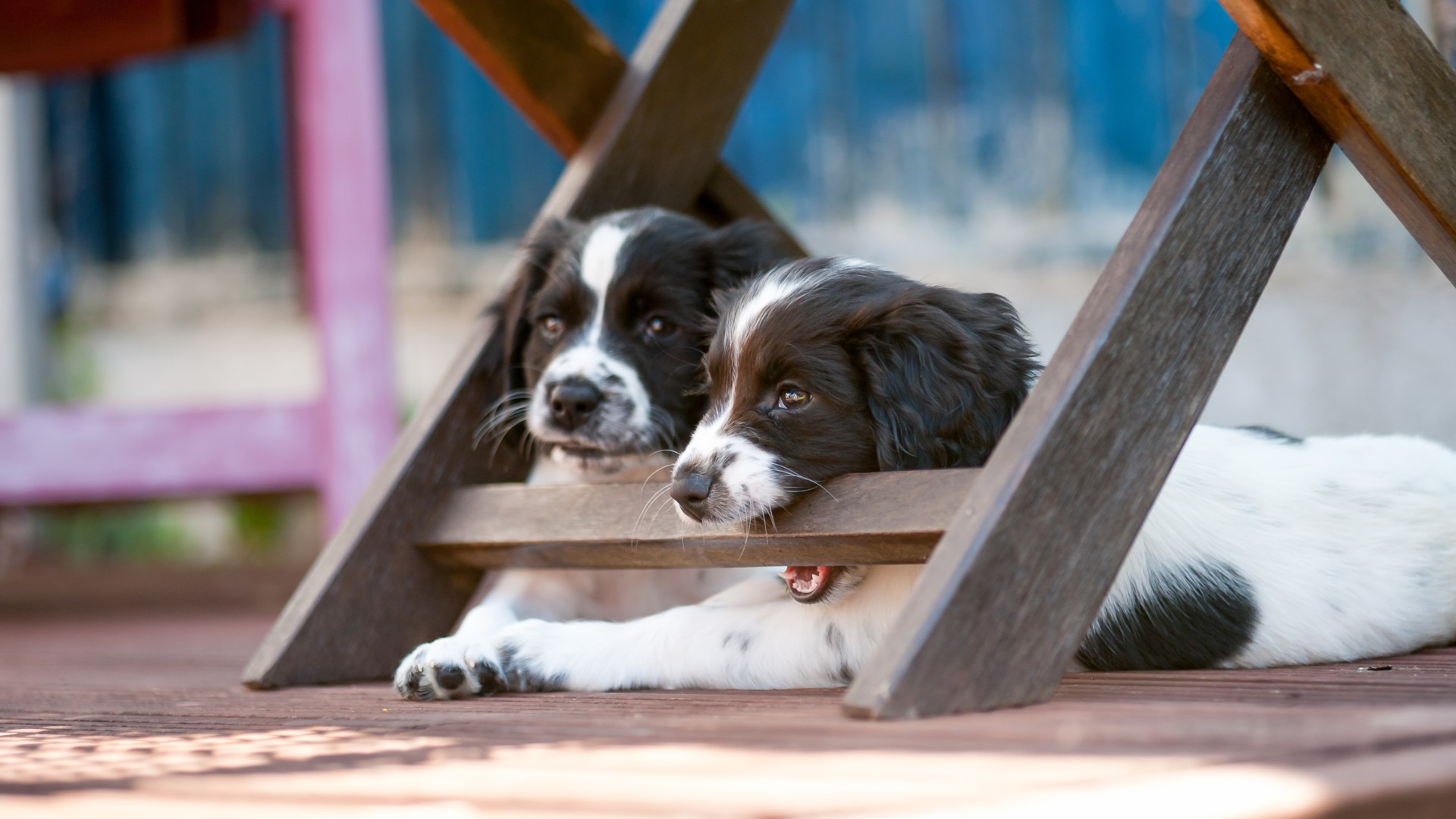How to puppy proof your house and yard
Want to know how to puppy proof your house? From keeping food out of reach in the kitchen to avoiding toxic plants in the garden, our tips have you covered

If you’re excited to be bringing home a new puppy, but don’t want your place destroyed, you’ll want to know how to puppy proof your house. While investing in the best dog playpen is a great way to keep your baby bundle of fur contained when you're not able to keep an eye on them, there will be plenty of times you'll want your little one to be able to roam free. And that's exactly where this guide will come in handy.
Bringing home a puppy for the first time is so exciting, but it can also be nerve-racking if this is your first time being a pet parent. Our homes are full of all sorts of potential hazards that could harm a puppy, from toxic plants and foods that can cause serious illness and death to cables and wires that pose a strangulation risk.
While that might sound scary, it doesn't have to be. As long as you're aware of the various risks that may be present in your home, you can put strategies in place to protect your puppy and your belongings from the havoc that tiny teeth and paws can wreak! Having a puppy checklist for your home and yard will ensure that you can enjoy all of the benefits of having a dog with none of the worries.
Below, we walk you through every room of your house and reveal where danger might be lurking and how to go about preventing it. By the time you've finished reading, you'll know everything you need to know to keep your puppy stays safe and happy while ensuring your belongings are not broken or torn to pieces.
Why should you puppy proof your home and yard?
If you’re getting a new puppy you’ll want to make sure you puppy proof your home first. When your puppy arrives they’ll be confronted with new smells, sounds and textures. They’ll want to explore everything and, unfortunately, this often means chewing your shoes, knocking over vases, stealing your food and digging up your flower beds. The best pet cameras are a great way to keep an eye on them.
But it’s not only the destruction to your home and belongings you need to worry about. You also want to puppy proof your home to avoid potential risks to your new pup’s health. Chewing on the wrong plant could be toxic, if they get a hold of food such as chocolate they could get seriously ill, and loose cables could be a strangulation risk. It may take a bit of time and money, but it’s worth it to ensure your puppy and home are protected.
How to puppy proof your house
There’s a few golden rules for puppy proofing your home. If you don’t want it going in your dog’s mouth don’t leave it out, if it might fall make sure it’s secured, understand what is safe for your dog and establish boundaries. Throughout the house keep windows and doors closed so your dog doesn’t escape, keep areas tidy and clean and minimize clutter. This checklist will help you puppy proof your house room-by-room.
Kitchen/dining room

- Cleaning products could be lethal to your pet. Store all cleaning products either high up or keep them locked away so that your dog cannot access them.
- When you have a pet you’ll want to clean your kitchen regularly, especially when they’re shedding, drooling or bringing in dirt from the outside, but also to stop them picking up germs. However your pup is likely to lick surfaces such as floors and kitchen counters if they can jump up on them so it’s important to use pet-friendly, natural cleaning products that don’t contain any toxic ingredients and won’t cause them harm.
- While you may decide to feed your dog scraps from the table, you might want to discourage this so they’re not seeking out food. It’s also not a good idea to leave food out on the kitchen counters to tempt them. Not only do you not want your pup eating your food, but it could be fatal. Food such as chocolate, raisins and grapes, garlic, onion and chives and avocado can cause serious illness. Make sure you research which foods are dangerous to your dog and what food is best for your puppy, but best practice is to keep food in general out of reach.
- It’s not just food on your counter tops you need to worry about. Make sure your trash cans are secured tightly or that the rubbish is taken out so your puppy can’t get in to eat the scraps or, worse still, get hold of plastic. And close the dishwasher so they can’t access dirty dishes and dishwashing liquid.
- Keep plastic bags out of reach as this could cause suffocation.
- If you want your pup to avoid your food, research the best puppy food so they’re satisfied with their own food.
- Think about which objects in your kitchen could be of danger. Secure or put away sharp knives, use a stove guard if your pet can jump up as high as the hob and check that nothing breakable can be easily knocked over.
- Once you’ve checked the items on display, make sure your dog can’t access closed cupboards where you’ve put things away. You could add childproof locks to lower cabinets.
Living room/lounge
- If you’re worried about your puppy sitting on or scratching the furniture then choose your sofa material wisely, protect your furniture with washable covers and thick throws or position objects strategically to block off your pup’s access.
- When it comes to cushions try to avoid tassels and fringes which your pet may want to chew on.
- Don’t leave reclinable chairs open as they could injure themselves.
- If you have a fireplace block it off or buy a gate for your pet’s safety.
- Secure anything that could break, such as lamps or picture frames, or fall over and injure your pup.
- Put away any loose objects such as change or remote controls.
- Keep electrical cables and wires hidden away or protected so your dog does not chew on them or get tangled up.
- Do not leave curtain or blind cords loose as these could be a strangulation risk.
Bathroom
- Learning how to bathe a puppy can be a fun experience, but it’s a good idea to limit access to the bathroom, especially around bath time, because there’s a risk of drowning. Keep the door closed or use a baby gate.
- It’s also important to keep the toilet lid closed as your dog may try drink the water and you don’t want them consuming toilet cleaner.
- Bath products such as shampoo and soap should be kept out of reach in a cabinet or on an inaccessible shelf.
- Medicine should also be stored away so your dog cannot access it.
- Remember to unplug styling tools such as curling irons and tidy them away so your pet doesn’t get burnt or tangled up in the cables.
- Dirty clothes belong in the hamper anyway, but especially if you have a puppy so your clothes don’t get chewed or ruined.
Bedroom

- If you don’t want your puppy on your bed or bedroom furniture try blockading the furniture or otherwise make the bed every day so they don’t get their fur all over your sheets.
- Keep your bedroom tidy and avoid leaving clothes, shoes and toys on the floor as they may get chewed.
- Secure or store away any small items such as books, reading glasses and Airpods that may fall, be swallowed or get broken.
- Clean regularly to avoid small objects such as buttons or jewelry getting swallowed as these may be a choking hazard.
- Do not use moth balls in your wardrobe as these are toxic to dogs.
- You may want to keep any temperature control units covered or blocked off.
- Open bins are not a good idea. Make sure bins are closed and your pup can’t get inside.
- If your puppy likes to spend time in your bedroom you could put some teething toys in there to keep their mouths occupied, but if you like your space and want them to sleep elsewhere we recommend researching the best puppy sleep training products and how to stop your puppy crying at night to make those night time separations easier on all of you.
Office/study
- There may be areas of the house that need to be off limits because it’s hard to minimize loose items in the room such as paper in an office. If closing doors doesn’t work you could try a dog pen or use their crate to limit areas at certain times of the day when they’re not getting your attention.
- Plants throughout the house should be chosen carefully to make sure they’re not toxic to your dog. You could always choose hanging plants as this will stop them nibbling on your plants or trying to dig up the soil.
- An office can be a dangerous place for your pup as there are lots of choking hazards such as paperclips and drawing pins. If your office is open perhaps keep office supplies locked in a drawer.
How to puppy proof outdoor areas
- When you get a puppy you’ll need to put up a good fence in your yard or outdoor areas so that your dog has the freedom to be outside, but so there’s a boundary and they cannot escape.
- Just as inside the home, plants outdoors need to be chosen carefully. Avoid anything thorny or poisonous.
- If you don’t want your vegetable patch or flower beds dug up, make sure they are secure, raised or have a protective barrier around them.
- Keep your lawn cut neat and tidy at all times to avoid ticks.
- Don’t leave dangerous and sharp gardening tools out as your pet could get injured.
- Store any toxic materials such as paint and pesticides locked away in your shed.
- If you have a swimming pool or a pond, block off access to avoid the risk of drowning.
- If you love your garden and are worried about your dog destroying it, why not create a space in the yard just for them so they have their own patch to play in and dig up.
How to puppy proof furniture

- When choosing furniture go for pet-friendly materials such as leather, which is easy to clean, or something durable like microfibre.
- If you’ve already got your furniture you could protect it with covers or removable and washable seats.
- Try to avoid bare wood as your dog may chew on it. If you can’t avoid it, there are pet-safe products you can spray on wood such as bitter apple.
- Groom your puppy regularly to keep your house and furniture free from dog fur and dirt.
- Match your furniture to your dog. If your pup has black fur and your carpets are white you’ll have to do a lot of vacuuming. Try keep your furniture similar tones to your dog’s coat.
- If you don’t want your dog sleeping on your bed, why not invest in a luxury dog bed so they want to sleep in their own bed.
- If your dog is allowed to sit on the furniture, lint rollers can be handy to keep things clean.
- When you come in from the rain do you have a boot rack to get yourself sorted and avoid traipsing mud through the house? Create a similar area for your dog to clean themselves up before they enter the house.
- If you’re precious about any of your furniture perhaps close off certain rooms. Just make sure your dog has enough space, as well as physical and mental stimulation.
How to puppy proof an apartment
- If you live in a small apartment with a dog, it can be easy for the whole place to be a mess. Try create one area especially for your dog with lots of toys so you can keep the rest of the apartment clean.
- If you’re going to be out, apartments can be limiting for a puppy. Make sure you leave them lots of toys to play with while you’re away.
- Leave the radio or tv on while you’re out so that any sudden noises won’t make them start barking as they’re used to the background sounds.
- Find new ways of how to tire a puppy out to make up for the smaller space in an apartment.
If all else fails and your precious little pup is still tearing up the place you can learn how to discipline your puppy to how to stop a puppy chewing but hopefully puppy proofing your home is a good start.
PetsRadar Newsletter
Get the best advice, tips and top tech for your beloved Pets

